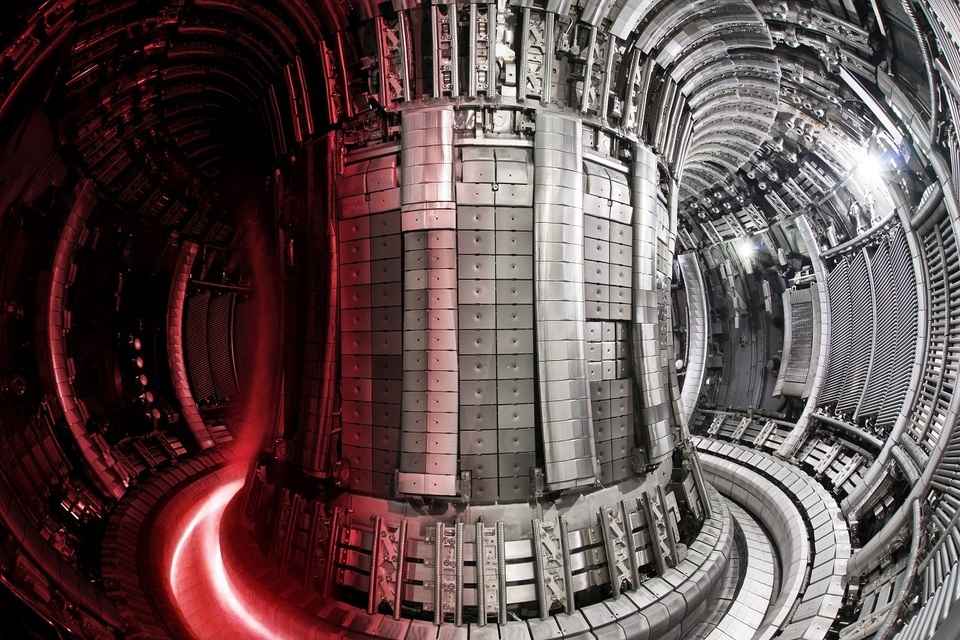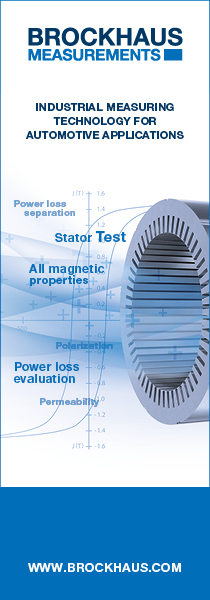Ewing Event ’22: The Road to Fusion
UKMagSoc
Dec 7th 2022 - Dec 7th 2022
York, United Kingdom
Updated 4/4/2023

Of all applications of magnetic technology, nuclear fusion offers the greatest potential benefit. The ability to generate emissions free electricity from simple fuels has been a dream for centuries, and an achievable goal for decades.
 This year’s Ewing Event will look at the different routes to commercial fusion. Speakers will give a general state of play with the idea of commercial systems being available in 5 years, as well as the design of components and systems.
This year’s Ewing Event will look at the different routes to commercial fusion. Speakers will give a general state of play with the idea of commercial systems being available in 5 years, as well as the design of components and systems.
Current plans for the Ewing Event include:
- a full day technical seminar
- lab tours of:
York Plasma Institute
Fusion Centre for Doctoral Training
- the prestigious Ewing Lecture
- reception and informal dinner
The Ewing Event will take place at the Ron Cooke Hub at the University of York, UK, and the dinner will be held at Hilton York.
SEMINAR VENUE
Ron Cooke Hub,
Tiered Lecture Theatre,
University of York,
133 Deramore Lane, York
YO10 5GE (Sat Nav YO10 5LA)
DINNER VENUE
Hilton York,
1 Tower Street, York
YO1 9WD
United Kingdom
TOURS
York Plasma Institute Laboratories
Innovation Way,
Heslington, York
YO10 5DD
https://goo.gl/maps/qkgVJYZNwH3hFTw29
ACCOMMODATION
Hilton York
The offer for Hilton York has expired but please do check with the hotel to see if there are available rooms to book.
PROGRAMME
The event will run from 09:00-23:30 (UK time) and will include a full day of talks followed by a sit down dinner. A draft of the programme will be shared in due course.
DIETARY REQUIREMENTS
Please let us know as soon as possible if you have any dietary requirements we need to be aware of.
DRESS CODE
The dress code for the event is business attire / smart casual.
CONTINUING CONTACT / GDPR
Please note, by providing contact details during registration, you authorise us to
- use these contact details to let you know details of this event, and
- add your contact details to our contact database to let you know about future events that may be of interest.
Please let us know at enquiries@ukmagsoc.org at any time if you do not wish to be contacted in this way. Also, we can remove you from our contact schedule at any point in the future.
We will also be taking photos at the event. If you do not wish to have your photo taken during the event, please contact events@ukmagsoc.org
Sponsors


Event Travel Information
How to get to Ron Cooke, University of York
BY TRAIN
York has good public transport links. Trains to York from London take just under two hours, with trains from Edinburgh taking just under two and a half hours. A taxi from the station to York Conferences venues on Heslington West or Heslington East will cost approximately £10.
BY CAR
Directions from the A64:
Follow the outer ring road (A64 S&E or A1237 N&W) to the Hull/Bridlington (A1079/A166) roundabout. At the roundabout follow the road to York past B&Q on the right. At the next roundabout merge in to the left hand lane and turn left following signs for University of York. Go straight over the next roundabout (Campus East buildings in front of you). At the small roundabout turn left, you will see Field Lane car park and bus stops on your right hand side. Kimberlow Lane overflow car park is a little further down this road on your right hand side.
Directions from York:
Follow the signs to Hull A1079 and Bridlington A166 until reaching Hull Road, continue to drive along Hull Road towards the A64 Take the right hand turning towards Grimston Bar Park and Ride and the Sports Village at the small roundabout go straight ahead until reaching either Kimberlow Lane or Field Lane car park.
SatNav
Use postcode YO19 5LA to be directed to the Grimston Bar Park and Ride junction.
PARKING AT RON COOKE HUB
When you arrive at the campus, follow the road around to the left (Kimberlow Lane) and there is a car park on the right hand side. This is a pay and display car park.
How to get to the York Plasma Institute Labs:
We will be walking to the labs, but for anyone driving, you will need to put York Plasma Institutes Laboratories into your Sat Nav. York Plasma Institute (offices) on Church lane is the wrong place.
PARKING
Parking is available at the Ron Cooke Hub. Charges do apply.
The closest car park at the YPI Labs is the Campus Central Car Park (see https://www.york.ac.uk/about/transport-maps-parking/parking/pay-and-display/). This is pay and display
Parking is available at Hilton Hotel (subject to availability) Day parking: £12.50 Resident parking (overnight): £25.00
Speakers
An overview of the major challenges, Tokamak Energy's approach to solving the problems and coil development programmes
by Dr Greg Brittles of Tokamak Energy
On the route to developing a source of clean fusion energy, Tokamak Energy (TE) is developing Spherical Tokamak (ST) technology employing high temperature superconducting (HTS) magnets as a key enabling component. TE has embarked on a program of developing HTS magnets based on REBCO coated conductors for ST’s up to fusion reactor scale magnet sets. This presentation will summarise the challenges and the progress of that program to date.
You must be a member to download papers. Membership Information...
R&D on Magnet System of the European DEMO tokamak
by Kamil Sedlak of Swiss Plasma Center (SPC), EPFL
Following ITER, the European DEMO tokamak should be the first fusion power plant delivering electricity to the grid. Its magnet system shall consist of 16 Toroidal Field (TF) coils, 5 modules of the Central Solenoid (CS) and 6 Poloidal Field (PF) coils. Several improvements with respect to the ITER magnets are being investigated within the R&D program, namely the usage of Nb3Sn conductors based on react & wind (RW) technology and hybrid CS solenoid with the high-grade conductors made of HTS with the magnetic field up to 16 T. Several conductor prototypes of these kinds (RW Nb3Sn and HTS) have been manufactured and tested in the SULTAN test facility. We will report on the design of these conductors and magnets, and also on the tests of the prototype samples.
You must be a member to download papers. Membership Information...
Investigating REBCO Irradiation for STEP
by Simon Chislett-McDonald of UKAEA
As the materials of choice for the STEP (Spherical Tokamak for Energy Production) primary magnets, the effect of radiation on the functional properties of REBCO tapes must be known. Qualitatively, it is understood that neutron fluence degrades superconductor critical current density, critical temperature, and irreversibility field – though the magnitude of the degradation varies between different tape types and depends on both the conditions of radiation and the conditions of magnet operation. Here, we present the UKAEA-STEP plans for the quantification of these radiation effects with the aims of 1) informing the choice of the optimal tape(s) for the STEP magnets and 2) characterising REBCO tapes under radiation to optimise magnet and shielding design.
You must be a member to download papers. Membership Information...
Development, qualification and lessons learned from conductor manufacture for ITER
by Neil Mitchell of Retired (formally Head of ITER Magnets)
During 35 years of the ITER project, we brought high current Nb3Sn and NbTi conductors from an early development phase to full industrialisation and production. In this presentation I will cover the main steps in this process, the main problems overcome and some lessons that could apply for the future for development of HTS conductors
You must be a member to download papers. Membership Information...
ITER Magnets and ITER Tokamak Assembly Status
by Min Liao of ITER Organization
ITER is the largest fully nuclear tokamak, with a target of 500MW of fusion power. It has been under construction at Cadarache since 2007, and has now reached the point where major on-site assembly activities are ongoing. The magnets represent by far the largest set of superconducting coils (Nb3Sn and NbTi) ever built and most have now been manufactured and many are on site.
ITER has provided much experience on large scale industrialisation of what has previously been largely a research activity, and the nuclear aspects of the machine have brought many novelties to the magnet field regarding nuclear quality expectations, as well as adding large scale construction requirements to the more familiar constraints of cryogenic high voltage magnets.
ITER is now facing some challenges regarding non-magnet tokamak components where quality standards have been deficient and recovery actions are now being implemented. Worldwide collaboration, such as the ITER cooperation, is seen as the way to work most efficiently and to achieve effective solutions to these scientific and technological challenges. However the improvement of organizational structure in some area, e.g, quality improvement as the integration approach for factory acceptance test and site acceptance test into a coherent and cost effective design, the mitigation and corrections will be able to build on the extensive experience gained so far.
Delivering Fusion Energy – the key role of magnets
by Howard Wilson of University of York
Fusion energy is rapidly accelerating its progress, as the urgency of addressing climate change drives a need to demonstrate its commercial viability by around 2050. This talk will focus on the challenges associated with achieving the fusion conditions, focusing on the magnetic confinement approach. We will explore the required plasma conditions in an accessible way, and discuss why the magnetic field plays such an important role in achieving these conditions. The consequences for the different approaches to magnetic confinement fusion will be explored, highlighting the similarities and differences between the conventional tokamak (e.g. JET and ITER) and the spherical tokamak (e.g. MAST-U, ST40 and STEP), and introducing the stellarator.
You must be a member to download papers. Membership Information...
Magnetics Challenges in Fusion
by Elizabeth Surrey of N/A (Retired UKAEA)
The magnetics challenge in developing fusion is two way: the challenges that fusion presents to magnetics and the challenges that feasibility present to fusion. The talk will discuss some examples, concentrating on the needs of fusion power plants.
You must be a member to download papers. Membership Information...
Validations of a High-Performance Computing model for HTS in Fusion.
by Neil Lamas and Oriol Fernández Serracanta of Barcelona’s institute of material sciences (ICMAB), Instituto de Ciencia de Materiales de Barcelona (ICMAB) and Barcelona Supercomputing Center – Centro Nacional de Supercomputación (BSC-CNS)
We implemented and validated “Magnet” an electromagnetic module of Alya, a high performance computing multiphysics simulation code; a module applied to simulate High Temperature Superconductors (HTS) for Fusion reactors development.
Experimental measurements of in-field cooling and hysteresis losses were carried out, and compared to simulations in order to validate and upgrade the model .
You must be a member to download papers. Membership Information...
The CHIMERA Fusion Technology Facility magnet system
by Tom Barrett of UK AEA
The CHIMERA fusion technology test facility is under construction at the UKAEA site in South Yorkshire, UK. The facility will be uniquely capable of ‘semi-integral’ testing of fusion materials and component modules, up to the size of the ITER ‘test blanket’, under combined heating and magnetic load conditions. The unique capabilities of CHIMERA have led to the design and manufacture of a challenging and unusual magnet system. The main superconducting magnet is in a split pair arrangement, with coils on both lateral sides of the component test chamber. The central field for testing can be up to 4 Tesla, and a high field gradient leads to large static lateral forces up to 160 kN. The system also features a copper pulsed magnet, enabling fusion component prototypes to be subjected to repeated magnetic field pulses with ramp rate 12 T/s, to simulate loading conditions of a fusion plasma disruption. This talk gives an overview of the CHIMERA capabilities, with a focus on the design and challenges of the magnet system.
You must be a member to download papers. Membership Information...
Programme
| Time | Session Title | Session Host |
|---|
| 09:00 | Registration | |
| 09:45 | Welcome | |
| 10:00 | Delivering Fusion Energy – the key role of magnets | Howard Wilson, University of York |
| 10:30 | Investigating REBCO Irradiation for STEP | Simon Chislett-McDonald, United Kingdom Atomic Energy Authority |
| 11:00 | Validations of a High-Performance Computing model for HTS in Fusion | Neil Lamas, Barcelona’s institute of material sciences (ICMAB) and Oriol Fernández Serracanta, Barcelona Supercomputing Center – Centro Nacional de Supercomputación (BSC-CNS) |
| 11:30 | ITER Magnets and ITER Tokamak Assembly Status | Min Liao, ITER Organanisation |
| 12:00 | Lunch | |
| 13:00 | Development, qualification and lessons learned from conductor manufacture for ITER | Neil Mitchell, (Retired) Former Head of ITER Magnets |
| 13:30 | An overview of the major challenges, Tokamak Energy's approach to solving the problems and coil development programmes. | Dr Greg Brittles DPhil MPhys, Tokamak Energy Ltd |
| 14:00 | Coffee break | |
| 14:30 | R&D on Magnet System of the European DEMO tokamak | Kamil Sedlak, Swiss Plasma Center (SPC), EPFL |
| 15:00 | The CHIMERA Fusion Technology Facility magnet system | Tom Barrett, UKAEA |
| 15:30 | Comfort break | |
| 15:45 | Ewing Lecture: Magnetics Challenges in Fusion | Elizabeth Surrey, (Retired) UKAEA |
| 16:45 | Close | |
| 17:00 | Walk to tours | |
| 17:15 | Tours | |
| 18:00 | End of tours | |
| 18:00 | Bus journey to Hilton York | |
| 18:30 | Drinks reception at Hilton York | |
| 19:30 | Dinner | |
| 23:30 | End of Dinner | |

 This year’s Ewing Event will look at the different routes to commercial fusion. Speakers will give a general state of play with the idea of commercial systems being available in 5 years, as well as the design of components and systems.
This year’s Ewing Event will look at the different routes to commercial fusion. Speakers will give a general state of play with the idea of commercial systems being available in 5 years, as well as the design of components and systems.




